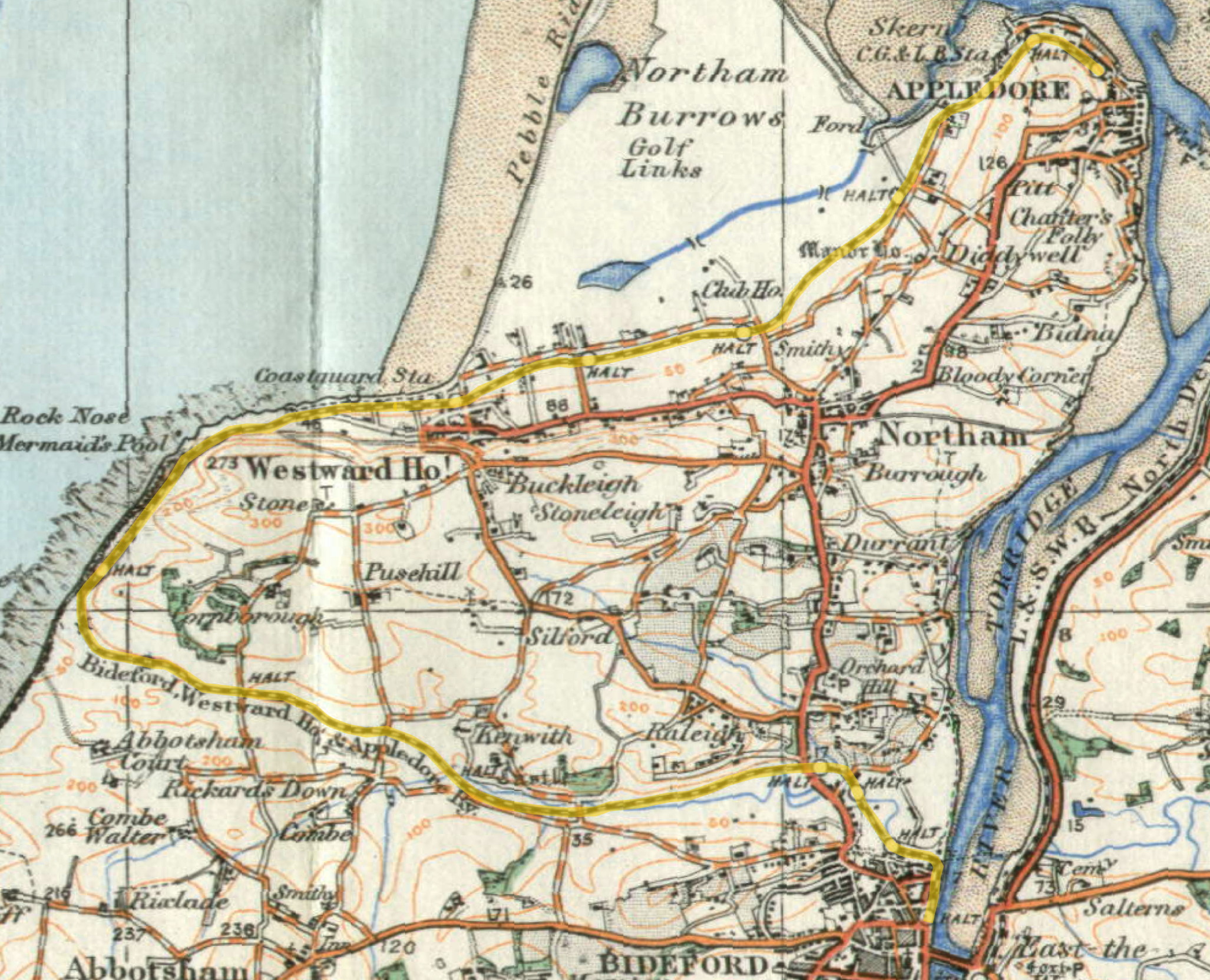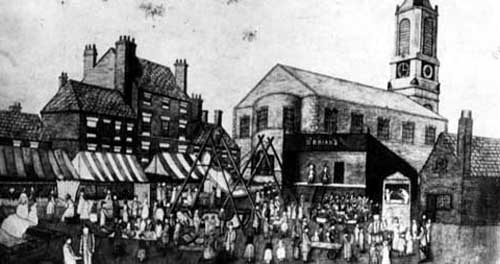|
Bideford, Westward Ho! And Appledore Railway
The Bideford, Westward Ho! and Appledore Railway (B, WH & A, R) was a railway running in northwest Devon, England. It is unusual in that although it was built as a standard gauge line, it was not joined to the rest of the British railway network, despite the London and South Western Railway having a station at Bideford East-the-Water, just on the other side of the river Torridge from the main town. The line was wholly situated on the peninsula made up of Westward Ho!, Northam and Appledore with extensive sand dunes by the Torridge and Taw estuary. The line opened in stages between 1901 and 1908, but closed in 1917, having been requisitioned by the War Office. Re-opening the line after World War I was considered, but dismissed as a viable option. The B.WH!&A.R. was the only railway company in the British Isles to have an exclamation mark in its company title. Charles Kingsley wrote the novel ''Westward Ho!'', which led to a tourist boom on the peninsula, followed by the constru ... [...More Info...] [...Related Items...] OR: [Wikipedia] [Google] [Baidu] |
Map BWHA Railway
A map is a symbolic depiction emphasizing relationships between elements of some space, such as objects, regions, or themes. Many maps are static, fixed to paper or some other durable medium, while others are dynamic or interactive. Although most commonly used to depict geography, maps may represent any space, real or fictional, without regard to context or scale, such as in brain mapping, DNA mapping, or computer network topology mapping. The space being mapped may be two dimensional, such as the surface of the earth, three dimensional, such as the interior of the earth, or even more abstract spaces of any dimension, such as arise in modeling phenomena having many independent variables. Although the earliest maps known are of the heavens, geographic maps of territory have a very long tradition and exist from ancient times. The word "map" comes from the , wherein ''mappa'' meant 'napkin' or 'cloth' and ''mundi'' 'the world'. Thus, "map" became a shortened term referring t ... [...More Info...] [...Related Items...] OR: [Wikipedia] [Google] [Baidu] |
Single Track (rail)
A single-track railway is a railway where trains traveling in both directions share the same track. Single track is usually found on lesser-used rail lines, often branch lines, where the level of traffic is not high enough to justify the cost of constructing and maintaining a second track. Advantages and disadvantages Single track is significantly cheaper to build and maintain, but has operational and safety disadvantages. For example, a single-track line that takes 15 minutes to travel through would have capacity for only two trains per hour in each direction safely. By contrast, a double track with signal boxes four minutes apart can allow up to 15 trains per hour in each direction safely, provided all the trains travel at the same speed. This hindrance on the capacity of a single track may be partly overcome by making the track one-way on alternate days, if the single track is not used for public passenger transit. Long freight trains are a problem if the passing s ... [...More Info...] [...Related Items...] OR: [Wikipedia] [Google] [Baidu] |
Kilonewton
The newton (symbol: N) is the unit of force in the International System of Units (SI). It is defined as 1 kg⋅m/s, the force which gives a mass of 1 kilogram an acceleration of 1 metre per second per second. It is named after Isaac Newton in recognition of his work on classical mechanics, specifically Newton's second law of motion. Definition A newton is defined as 1 kg⋅m/s (it is a derived unit which is defined in terms of the SI base units). One newton is therefore the force needed to accelerate one kilogram of mass at the rate of one metre per second squared in the direction of the applied force. The units "metre per second squared" can be understood as measuring a rate of change in velocity per unit of time, i.e. an increase in velocity by 1 metre per second every second. In 1946, Conférence Générale des Poids et Mesures (CGPM) Resolution 2 standardized the unit of force in the MKS system of units to be the amount needed to accelerate 1 kilogram of mass at the rate o ... [...More Info...] [...Related Items...] OR: [Wikipedia] [Google] [Baidu] |
Pound-force
The pound of force or pound-force (symbol: lbf, sometimes lbf,) is a unit of force used in some systems of measurement, including English Engineering units and the foot–pound–second system. Pound-force should not be confused with pound-mass (lb), often simply called ''pound'', which is a unit of mass, nor should these be confused with foot-pound (ft⋅lbf), a unit of energy, or pound-foot (lbf⋅ft), a unit of torque. Definitions The pound-force is equal to the gravitational force exerted on a mass of one avoirdupois pound on the surface of Earth. Since the 18th century, the unit has been used in low-precision measurements, for which small changes in Earth's gravity (which varies from equator to pole by up to half a percent) can safely be neglected. The 20th century, however, brought the need for a more precise definition, requiring a standardized value for acceleration due to gravity. Product of avoirdupois pound and standard gravity The pound-force is the product ... [...More Info...] [...Related Items...] OR: [Wikipedia] [Google] [Baidu] |
Hundredweight
The hundredweight (abbreviation: cwt), formerly also known as the centum weight or quintal, is a British imperial and US customary unit of weight or mass. Its value differs between the US and British imperial systems. The two values are distinguished in American English as the "short" and "long" hundredweight and in British English as the "cental" and the "imperial hundredweight". * The short hundredweight or cental of is used in the United States. * The long or imperial hundredweight of 8 stone or is defined in the imperial system. Under both conventions, there are 20 hundredweight in a ton, producing a " short ton" of 2,000 pounds and a " long ton" of 2,240 pounds. History The hundredweight has had many values. In England in around 1300, different "hundreds" (''centum'' in Medieval Latin) were defined. The Weights and Measures Act 1835 formally established the present imperial hundredweight of 112 lb. The United States and Canada came to use the ter ... [...More Info...] [...Related Items...] OR: [Wikipedia] [Google] [Baidu] |
Kilopascal
The pascal (symbol: Pa) is the unit of pressure in the International System of Units (SI), and is also used to quantify internal pressure, stress, Young's modulus, and ultimate tensile strength. The unit, named after Blaise Pascal, is defined as one newton per square metre and is equivalent to 10 barye (Ba) in the CGS system. The unit of measurement called standard atmosphere (atm) is defined as 101,325 Pa. Common multiple units of the pascal are the hectopascal (1 hPa = 100 Pa), which is equal to one millibar, and the kilopascal (1 kPa = 1000 Pa), which is equal to one centibar. Meteorological observations typically report atmospheric pressure in hectopascals per the recommendation of the World Meteorological Organization, thus a standard atmosphere (atm) or typical sea-level air pressure is about 1013 hPa. Reports in the United States typically use inches of mercury or millibars (hectopascals). In Canada these reports are given in kilopascals ... [...More Info...] [...Related Items...] OR: [Wikipedia] [Google] [Baidu] |
Pounds Per Square Inch
The pound per square inch or, more accurately, pound-force per square inch (symbol: lbf/in2; abbreviation: psi) is a unit of pressure or of stress based on avoirdupois units. It is the pressure resulting from a force of one pound-force applied to an area of one square inch. In SI units, 1 psi is approximately equal to 6895 Pa. Pounds per square inch absolute (psia) is used to make it clear that the pressure is relative to a vacuum rather than the ambient atmospheric pressure. Since atmospheric pressure at sea level is around , this will be added to any pressure reading made in air at sea level. The converse is pounds per square inch gauge (psig), indicating that the pressure is relative to atmospheric pressure. For example, a bicycle tire pumped up to 65 psig in a local atmospheric pressure at sea level (14.7 psi) will have a pressure of 79.7 psia (14.7 psi + 65 psi). When gauge pressure is referenced to something other than ambient atmospheric pressure, then the u ... [...More Info...] [...Related Items...] OR: [Wikipedia] [Google] [Baidu] |
Hunslet Engine Co
Hunslet () is an inner-city area in south Leeds, West Yorkshire, England. It is southeast of the city centre and has an industrial past. It is situated in the Hunslet and Riverside ward of Leeds City Council and Leeds Central parliamentary constituency. The population of the previous City and Hunslet council ward at the 2011 census was 33,705. Many engineering companies were based in Hunslet, including John Fowler & Co. manufacturers of traction engines and steam rollers, the Hunslet Engine Company builders of locomotives (including those used during the construction of the Channel Tunnel), Kitson & Co., Manning Wardle and Hudswell Clarke. Many railway locomotives were built in the Jack Lane area of Hunslet. The area has a mixture of modern and 19th century industrial buildings, terraced housing and 20th century housing. It is an area that has grown up significantly around the River Aire in the early years of the 21st century, especially with the construction of modern r ... [...More Info...] [...Related Items...] OR: [Wikipedia] [Google] [Baidu] |
2-4-2
Under the Whyte notation for the classification of steam locomotives, represents the wheel arrangement of two leading wheels on one axle, four powered and coupled driving wheels on two axles and two trailing wheels on one axle. The type is sometimes named Columbia after a Baldwin Locomotive Works, Baldwin locomotive was showcased at the 1893 World's Columbian Exposition held at Chicago, Illinois. Overview The wheel arrangement was widely used on passenger tank locomotives during the last three decades of the nineteenth and the first decade of the twentieth centuries. The vast majority of 2-4-2 locomotives were Tank locomotive, tank engines, designated 2-4-2T. The symmetrical wheel arrangement was well suited for a tank locomotive that is used to work in either direction. When the leading and trailing wheels are in swivelling trucks, the equivalent UIC classification is 1'B1'. While a number of 2-4-2 tender locomotives were built, larger tender locomotive types soon became do ... [...More Info...] [...Related Items...] OR: [Wikipedia] [Google] [Baidu] |






